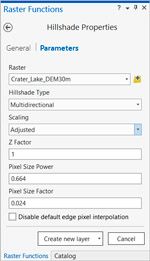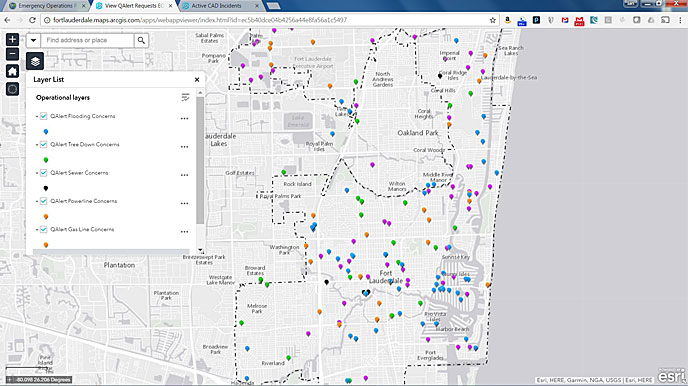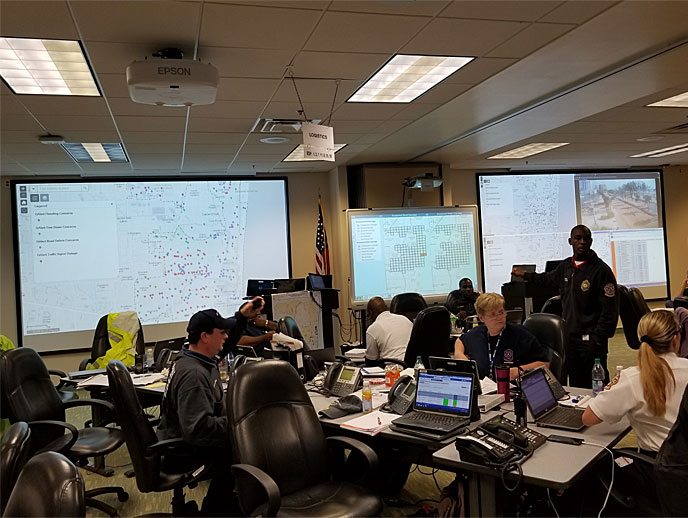Create an Open Data Site in Three Steps
By Katelyn MacDonald
Technical Solutions Specialist, Esri Canada
It’s easy to create a publicly accessible site for sharing data in a variety of formats with ArcGIS. If your organization has an
ArcGIS Online subscription, you already have access to the comprehensive open data capabilities the ArcGIS platform offers—they are free and come included as part of your subscription. Once open data is enabled for an ArcGIS Online Organization, the management of that open data occurs inside
ArcGIS Hub.
ArcGIS Hub is a new and separate product that can be purchased to help governments improve how they engage and collaborate with their communities. Since open data capabilities are now managed inside ArcGIS Hub, open data users can preview some of these new ArcGIS Hub capabilities, but won’t have access to all of them unless they purchase an ArcGIS Hub license. Either way, whether you are an ArcGIS Online subscriber, or an ArcGIS Hub user, you can take advantage of the ArcGIS platform’s open data capabilities and launch an open data site in these three straightforward steps.
The blog post “
9 tips to ensure high-quality open data downloads" provides the foundation for getting ready to launch an open data site. Once a plan has been developed and your data has been described and organized, the next step is to move it to the open data site. Not only do you need to make the data available to your users, you also want to provide a site that's easy to navigate and showcases your organization's unique brand. If you need ideas on how to develop your open data objectives, I suggest reading
"4 ways to drive open data program success."
In this tip, you will learn the technical aspects of launching your open data site.
With the 2.0 version of ArcGIS Hub, organizations now have more control over the flow and feel of their open data sites, making them more accessible and interactive for data users. With the introduction of charts and widgets, ArcGIS Hub 2.0 facilitates increased collaboration between data providers and the community. The new version also
enables file geodatabase downloads, a functionality that's been highly requested by users. For more information on what's new with ArcGIS Hub 2.0, read this
ArcGIS Blog post.
You can set up your open data site in three steps:
Step 1: Configure the open data site.
To enable open data capabilities in your organization's ArcGIS Online site, navigate to Organization > Edit Settings, then click the Open Data tab along the left-hand side of the page.

Click the ENABLE OPEN DATA button. You can come back to this Open Data tab in the future to manage your sites or to disable open data if you so choose.

Once you have open data groups created, you will see them listed in the open data pane. You can also use this pane to assign group members to open data groups, or go to the View My Content page to share data to your open data groups.
The MANAGE SITES button will take you to the ArcGIS Hub administrative application. Also on this page are the ASSIGN GROUP MEMBERS and VIEW MY CONTENT buttons. Staff in the Administrator role of your organization can click the ASSIGN GROUP MEMBERS button to batch assign a batch of ArcGIS Online members to your open data group. Clicking the VIEW MY CONTENT button takes you to the Content tab of ArcGIS Online.

Work with the Open Data Site Manager
Click the MANAGE SITES button to open the Site Manager page. This is where an open data administrator, can create an open data site or visit, manage, and edit an existing site by clicking its name. Each open data site is listed on this page, along with the associated management functionalities.
To create your first open data site, click the green Create New Site button.
The Site Configuration page is used to create the open data site.

- Site Name—Provide a name for the site. The name displayed will inform users which open data site they are visiting.
- Site URL—Choose the URL that will be used to navigate to your open data site.
- Browser Icon—You can upload a custom icon that displays on the left of the site URL in the browser.
- Custom Domain—Configure a custom domain name server (DNS). Check with your domain name registrar for details on configuring your DNS.
- Google Analytics—If you want to use Google Analytics to track the usage of your open data site, you can input the tracking ID.
- Sharing settings—You can choose to share your site with the ArcGIS Hub team only, your entire organization, or the public.
- Enforce HTTPS—open data sites are accessible over HTTPS, however, sites with custom domains are not accessible over HTTPS. You can test whether the site works over HTTPS by clicking Test Your Site First.
- Set Extent map—Either choose Draw Extent or Map Navigation to select the map extents of the data you will be uploading to the open data site.
- Basemaps—Use default basemaps or custom basemaps from your organization's basemap gallery.

Clicking Next will bring you to the Groups Manager. This is where you add data to your open data site. By clicking the green Add button (next to your group name under Available Open Data Groups, you will be adding all the data associated with this group to the site. If you intend to federate your open data site across multiple organizations, you can disable the selection of the option Only groups in your Organization to view all groups publicly available to add to your site.
Step 2: Prepare and manage data in an open data-configured ArcGIS Online group.
ArcGIS Online Roles
There are specific
ArcGIS Online privileges that need to be granted to your users to enable and manage the open data site. These privileges are automatically granted to the Administrator role. For other roles, you will need to configure specific privileges based on the user's responsibilities. These privileges can be
granted and revokedin ArcGIS Online by an Administrator. If the user responsible for the open data site is not the administrator, specific privileges will need to be assigned to the user's ArcGIS Online role. Privileges include the following:
- Manage open data sites—This privilege enables the creation and management of the site. This is required if the administrator of the open data site does not have an Administrator role in ArcGIS Online.
- Make groups available to open data—This privilege is given to ArcGIS Online group managers. Group managers will also require the following privileges: Create, update, and delete; Share with groups; and Make groups visible to public.
The Share with groups privilege will be the only one required for colleagues who create data that will be consumed in the open data group but don't need to create the group or manage the open data site.
Then, these users must be added to your ArcGIS Hub. You do this within the ArcGIS Hub administrative application.
Once you've ensured that your
data is prepared, your next step is to share this data with an ArcGIS Online group to be used in the site. You can create a group or modify an existing one; just keep in mind that the purpose of the group is to share the data you plan to showcase on your site. Any data you add to the group will be added to your open data portal.
On the Groups tab of ArcGIS Online, click Create Group.
Populate the group descriptions with information that describes the group's purpose. It's a good practice to include "Open Data" in the name to make it easier to find this group when creating your open data site.
Meaningful tags will also assist group users and are mandatory inputs for group creation. Tags can be separated using commas. Ensure that the status is set to Public and you have checked the check box for Allow this group to be accessed in Open Data sites.

Make your group public and designate it as available for use in open data sites.
You can add the following types of data to the group to be used by the open data site (each will have its own dataset page on the site):
- Hosted feature services
- ArcGIS Server feature services
- ArcGIS Server map services
- Image services
- CSV files
- Web maps
- Word documents
- PDFs
You can add external URLs as well—these URLs would not have their own dataset page but would be searchable and could be accessed from the search results. This is handy when you have data or information on other sites that you'd like to be accessed from your open data site.
Data can be added to the group through the Content page of ArcGIS Online. After checking the white check box to the left of your data name, click Share > Access and choose to share the item with your open data group. Your open data groups will have "(Open Data)" at the end of their names to easily indicate which groups are being used in the site. You can add a batch of data to the group by checking multiple datasets in your Content before clicking Share.
Step 3: Design the look of your open data site and make it public
After clicking Next, you will be brought to the Site Editor, where you can configure the look and style of your open data site. Using the editor tools provided or your own HTML/Cascading Style Sheet (CSS) code, you can design the site's headers and footers. Use the theme and layout builder to customize the body of your site.

Use the Site Editor to configure your open data home page.
When you visit the Site Editor for the open data site for the first time, there's already a preconfigured layout and template for you to begin working with—just point to each element and click the associated gear icon. Conversely, you can click the Close (x) button on each element to remove the entire template as it stands, and start again from scratch. Any element can be resized by clicking and dragging. At any point in time when designing your site, you can click the Admin button in the Site Editor to go back to the configuration page for your open data site.
When designing your page, it's good to keep in mind how the public is going to interact with the site and discover new data. The Layout Builder has cards that you can drag onto the page to design your site however you like. Included in these elements are the following:
- Dataset—Use this card to highlight specific datasets or applications that you would like featured on the home page of your open data site. For example, a county may find that users are most interested in parcel data for its locality and thus may want to feature this dataset in any easily accessible spot on the first page.
- Category—The Category card can be used to group datasets by a search query. When a user clicks one of the categories, all datasets within the defined category are returned in the search results.
- Chart—This can be used to create simple charts. Alternatively, you can use a defined JSON specification to create a custom chart, and both will be updated automatically as the dataset is updated. A simple chart can be created from a dataset in the open data group: choose Build a chart and then Find a dataset. You will then be prompted to choose the field you would like to chart. Use JSON to build different types of charts and change the chart colors.
- iFrame—This card allows you to insert just about anything into your open data home page. Insert a URL to embed a web resource to the page, such as web maps or applications. You could also include a geoprocessing widget with a geoprocessing service used to complete a task for your users.
- Summary Statistics—This provides statistical information for a dataset that is dependent on the field type chosen to be highlighted. It can provide snapshots of information at a glance that is updated as a dataset is updated.
- Gallery—This card can be used to point to content by a group within your organization that you'd like to add to your home page, including web maps and applications.
After your site has been saved, you can navigate back to the Site Administrator page by clicking the Admin button in the Site Editor. You will see several other configuration options:
Sites
- Capabilities—Manage the capabilities associated with your open data site. At this time, there is the option to display PDFs and document links inside iFrames. There are other beta options available as well.
- Pages—Each open data site can have any number of pages. These pages can be used to showcase datasets or promote initiatives within the open data site, or however your organization would like.
Data
- The Data tab opens the Data Manager, a management tool that administrators can use to identify issues with datasets in the open data site. This is where you can also disable automatic download caching when users download datasets (use the toggle if it's available) and manually refresh datasets to ensure that they are the most up-to-date version (arrow button). One recommendation is to disable automatic download caching for datasets that are large or don't change very often.
Team
- All open data users can view the Team manager to see who can collaborate in sites and pages. Administrators can also add and remove members from the open data team.
Once you've designed the look and functionality of your open data site, click the Preview Site tab to look at your handiwork! Do you see all the data you would like to make available to your users? Is the site easy to navigate and visually appealing? You'll want to keep in mind the audience for your open data when fine-tuning the site.
If you navigate away from the Site Builder page at any time, you can reopen it by clicking Organization > Edit Settings > Open Data tab > Manage Sites. Under each of your open data site names, there are buttons to direct you to the configuration pages for the site. This is also where you make your site public by toggling to choose Share with the public. Once you've finished designing the site, be sure to make it public so that users can visit it.
That's it! You've successfully launched your open data site. Don't forget to promote your site so that the public can easily discover, download, and use your authoritative open data to solve problems.
You can take your open data even further by using the Community and Initiatives premium capabilities of ArcGIS Hub. Learn more about how to license ArcGIS Hub and get access to these additional community engagement and initiative creation features at
esri.com/hub.

























